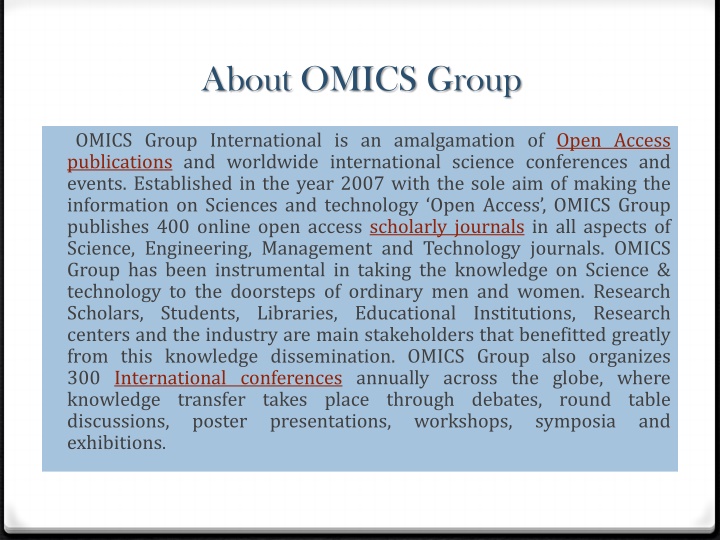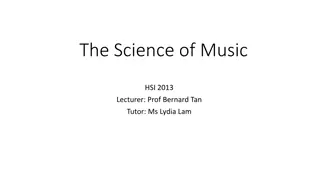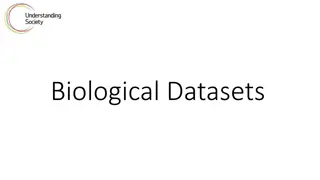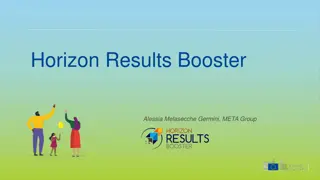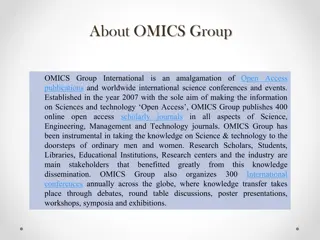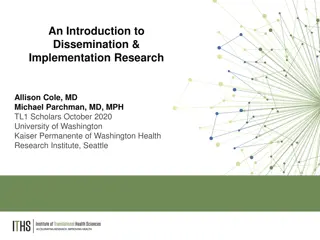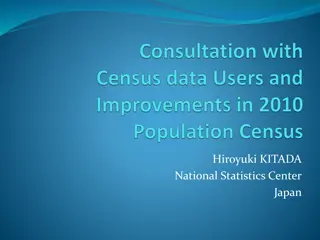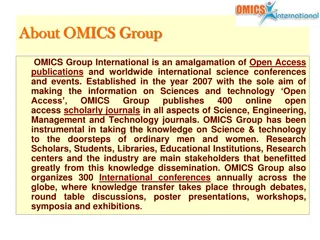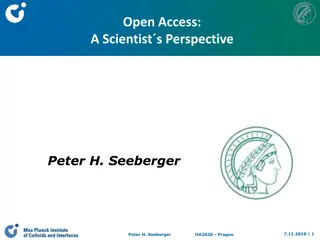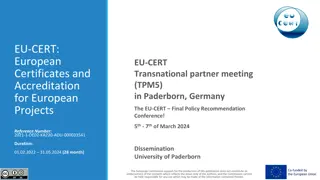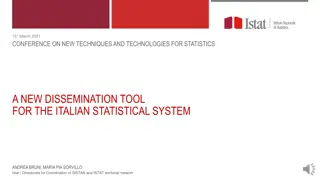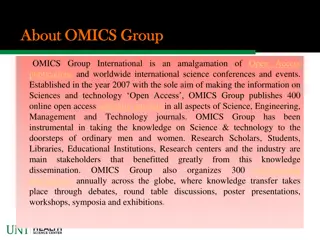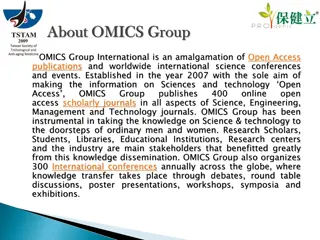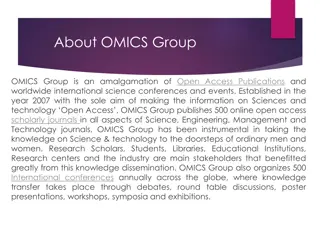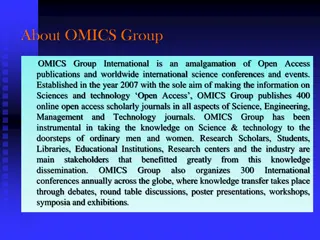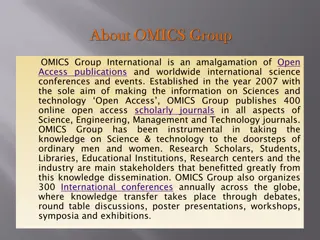OMICS Group: Revolutionizing Science and Technology Dissemination
OMICS Group International, established in 2007, is a leading amalgamation of open-access publications and global scientific conferences. With a commitment to making science and technology information freely accessible, OMICS Group publishes 400 online scholarly journals covering various fields. The organization also hosts 300 international conferences annually, facilitating knowledge dissemination through debates, presentations, and workshops. Additionally, OMICS Group plays a vital role in advancing HIV testing and counseling, highlighting the importance of early diagnosis and treatment. Utilizing multilevel modeling approaches, OMICS Group strives to identify factors influencing healthcare access and behavior.
Uploaded on Sep 23, 2024 | 2 Views
Download Presentation

Please find below an Image/Link to download the presentation.
The content on the website is provided AS IS for your information and personal use only. It may not be sold, licensed, or shared on other websites without obtaining consent from the author.If you encounter any issues during the download, it is possible that the publisher has removed the file from their server.
You are allowed to download the files provided on this website for personal or commercial use, subject to the condition that they are used lawfully. All files are the property of their respective owners.
The content on the website is provided AS IS for your information and personal use only. It may not be sold, licensed, or shared on other websites without obtaining consent from the author.
E N D
Presentation Transcript
About OMICS Group OMICS Group International is an amalgamation of Open Access publications and worldwide international science conferences and events. Established in the year 2007 with the sole aim of making the information on Sciences and technology Open Access , OMICS Group publishes 400 online open access scholarly journals in all aspects of Science, Engineering, Management and Technology journals. OMICS Group has been instrumental in taking the knowledge on Science & technology to the doorsteps of ordinary men and women. Research Scholars, Students, Libraries, Educational Institutions, Research centers and the industry are main stakeholders that benefitted greatly from this knowledge dissemination. OMICS Group also organizes 300 International conferences annually across the globe, where knowledge transfer takes place through debates, round table discussions, poster presentations, exhibitions. workshops, symposia and
About OMICS Group Conferences OMICS Group International is a pioneer and leading science event organizer, which publishes around 400 open access journals and conducts over 300 Medical, Clinical, Engineering, Life Sciences, Pharma scientific conferences all over the globe annually with the support of more than 1000 scientific associations and 30,000 editorial board members and 3.5 million followers to its credit. OMICS Group has organized 500 conferences, workshops and national symposiums across the major cities including San Francisco, Las Vegas, San Antonio, Omaha, Orlando, Raleigh, Santa Clara, Chicago, Philadelphia, Baltimore, United Kingdom, Valencia, Dubai, Beijing, Hyderabad, Bengaluru and Mumbai.
Multilevel modelling approach to identify factors affecting HIV testing and counselling among women who were attending antenatal care services in Ethiopia 21/10/2014 Wondwossen Lerebo, Debra Jackson, Christina Zarowsky, Marleen Temmerman, Steven Callens 3
HIV counseling and testing 0vitally important in order to access treatment 0knowledge of one s status can lead to behaviors to protect other people from infection 0Less than one in five people who are infected with HIV in Ethiopia know their status 0Too many people are presenting for treatment at a late stage in HIV disease 4
Factors affecting 0 The use of single-level analytical techniques in prior research ignores possible clustering. 0 it discards hierarchical structuring of data on individuals living in different households, neighbourhoods, cities, and provinces. 0 Multilevel modelling that can simultaneously account for factors at individual and neighbourhood levels is likely to provide a more robust and sophisticated understanding of factors associated with HCT uptake. 0 A woman HCT accessing behavior is nested at the health facility, health facility is nested in district 5
Multilevel modelling 0This study aimed to elucidate individual and community level factors associated with the uptake of 0 HIV Counselling and Testing (HCT) by implementing a hierarchical (multilevel) methodological approach.
Cont 0Multilevel modelling was developed in response to the challenge of appropriately analysing clustered data. 0This technique preserves the original data structure (i.e., individual level variables need not be aggregated to group means) while explicitly modelling the within-group homogeneity of errors by allowing the estimation of error terms for both the individual and the group.
Methodology 0 cross-sectional study design 0 multistage sampling technique 0 in which health facilities first selected (stage 1) 0 followed by recruitment of post-partum women who come for child immunization from each health facility (stage 2) in Tigray region Study population 0 population of this study constitute the post-partum women who were attending the health facility for the child immunization 8
Sampling procedures From 46 districts 50 health facilities (one bigger and well functioning facility) from each selected From each health facility systematically sampled 30-36 post-partum women interviewed If the selected facility is medium the sampling was purposive until we get the needed size If it is not possible to attain 30 in the facility the nearest one in the same district to attain the desired size 9
Data management & data analysis 0Data captured and analyzed using STATA v11 0Analyses included descriptive and analytic statistics 0Multilevel regression modeling used to examine different levels of factors in hierarchical models 0Ethical consideration 0Permission to conduct the source studies granted from the Ethics Committee of the University of the Western Cape and from Tigray Region Bureau of Health 10
Results Variables HCT Utilized N(%) Single level full model Multilevel full model Mother educ None Primary Secondary/H 353(68.5) 387(78.8) 372(84.6) 1 1.28 (0.803-2.049) 1.06 (0.585-1.936) 1 1.23 (0.749-2.015) 1.06 (0.564-2.000) Father educ None Primary Secondary/H 1 1.26 (0.805-1.976) 1.12 (0.644-1.968) 1 1.44 (0.890-2.339) 1.35 (0.738-2.484) 261(66.6) 378(78.3) 465(82.9) Ever utilized ANC Yes No 959(82.9) 152(53.0) 4.16 (2.705-6.407) 1 4.54 (2.815-7.328) 1 Get enc. From hus Yes No Know HCT sites Yes No 911(83.6) 194(56.2) 1.94 (1.272-2.963) 1 1.97 (1.252-3.104) 1 983(80.0) 127(59.3) 1.64 (0.988-2.710) 1 1.95 (1.114-3.398) 1 Knowledge level Poor Good SES quintile 1st quintile 2nd quintile 3rd quintile 4th quintile 5th quintile 561(71.6) 548(83.2) 1 1.81 (1.236-2.646) 1 1.44 (0.904-2.284) 220(65.9) 252(78.5) 253(74.4) 179(83.3) 210(88.2) 1 1.18 (0.691-2.009) 0.66 (0.368-1.193) 1.60 (0.729-3.523) 1.76 (0.779-3.981) 1 1.17 (0.658-2.071) 0.65 (0.341-1.241) 1.71 (0.735-3.960) 1.59 (0.652-3.881) 11
Variables Single level full model Single level full model Multilevel full model Place of residence Urban Rural Results 390(83.9) 208(80.0) 170(70.2) 724(83.0) 380(67.4) 0.79 (0.486-1.281) 1 0.84 (0.484-1.450) 1 Proximity <1km 1-5kms >5kms 1 0.74 (0.470-1.170) 0.61 (0.380-0.963) 1 0.76 (0.461-1.260) 0.59 (0.346-1.019) Population per HCT site 24000 >24000 544(81.2) 570(73.3) 1 0.53 (0.329-0.868) 1 0.54 (0.267-1.079) Proportion of women with no education <30% 30-50% >50% Population per health workers 1500 >1500 476(77.9) 461(79.1) 177(69.7) 1 0.74 (0.487-1.121) 0.35 (0.209-0.599) 1 0.75 (0.449-1.261) 0.44 (0.217-0.892) 704(80.0) 410(72.2) 1 0.61 (0.383-0.978) 1 0.61 (0.307-1.206) 12
Discussion 0 In single-level logistic regression and multilevel modelling: 0 attending ANC was associated with the uptake of HCT. 0 It is consistent with studies conducted previously in Ethiopia 0 attributable to the women s exposure to information regarding HIV and PMTCT during the ANC follow-up. 0 Getting their husband s approval to access HCT. 0 Other studies; supportive husband significantly increased the likelihood of women s utilizing HCT. 0 This may be related to culture, traditional beliefs, and women s economic dependence on their husbands which includes their not having the freedom to make decisions regarding their own health. 13
Cont knowing an HCT site and uptake of HCT is an interesting finding, whereas knowledge level of HIV seems to make no significant difference for the uptake of HCT in multilevel modelling. community-level characteristics woman who is living in a given community with higher proportion of educated women has a higher chance of utilizing HCT Random effects of the districts of HCT utilization are significant. unmeasured factors operating at the community/ or district level play a significant role in determining women s getting HCT beyond the influence of individual-level factors. (20% in null and 11% in full model) 14
Conclusion 0 At the individual level 0 utilizing ANC and 0 getting approval from a spouse are consistently strong predictors of utilization of HCT in both single-level and multilevel logistic regression, 0 while other factors generally vary in magnitude and significance. 0 At the community-level 0 a significant predictor in utilizing HCT was where a district had more than 50% of the women without education, 0 suggesting that group illiteracy is an impediment to utilizing HCT in Tigray region, Ethiopia. 15
Limitation 0 Facility level factors were not addresses 0 mothers who did not patronize the immunization facilities were excluded 0 there may have been recall bias 0 social desirability bias may have been present 0 unmeasured individual factors may partly account for variations in the community-level factors 0 the administratively defined boundaries of districts might non-differentially misclassify individuals into inappropriate administrative boundaries 16
Thank you!! 17
